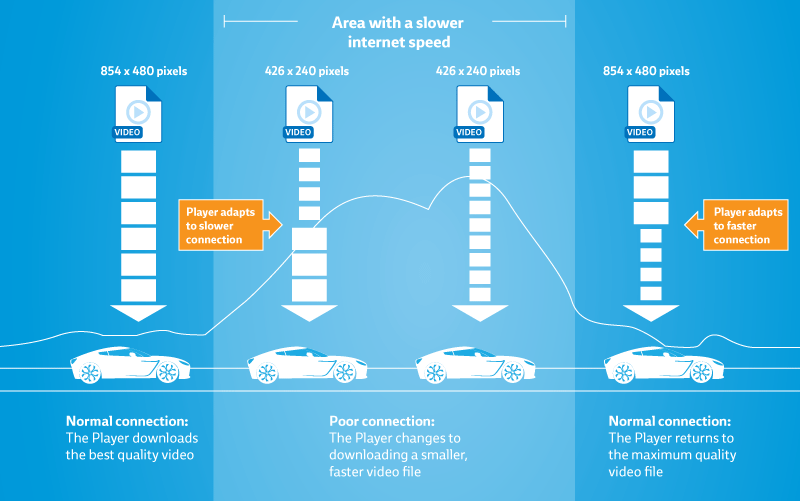In today’s digital world, video has become an essential part of any online business, whether it’s streaming services, e-learning, or video conferencing. However, one of the significant challenges that businesses face when delivering video content online is ensuring that viewers have a seamless experience. Adaptive bitrate streaming (ABR) is a technology that can help businesses overcome this challenge and provide a high-quality video experience to their users.
What is Adaptive Bitrate Streaming?
Adaptive bitrate streaming is a technique that enables the delivery of video content over the internet in multiple quality levels to adapt to the viewer’s internet connection speed. The ABR technology adjusts the video quality in real-time, depending on the user’s bandwidth and device capabilities, ensuring the viewer gets the best possible viewing experience.
How Does Adaptive Bitrate Streaming Work?
The ABR technology works by breaking the video file into small segments of varying bitrates. These segments are then delivered to the viewer’s device using a streaming protocol like HTTP Live Streaming (HLS) or Dynamic Adaptive Streaming over HTTP (DASH).
When the video playback starts, the player checks the user’s device’s capabilities and internet connection speed. The player then selects the appropriate bitrate segment, and the video playback starts at that quality level. As the viewer’s internet speed changes, the player automatically switches to the appropriate bitrate segment to maintain the video playback’s quality and stability.
More elaborately – adaptive bitrate streaming (ABR) technology works by dividing the video content into small segments of varying bitrates and then delivering them to the viewer’s device using a streaming protocol like HTTP Live Streaming (HLS) or Dynamic Adaptive Streaming over HTTP (DASH). When a viewer initiates playback of the video, the ABR player checks the user’s device capabilities and internet connection speed and selects the appropriate bitrate segment to start playback at.
As the video playback progresses, the ABR player monitors the viewer’s internet connection speed and adjusts the bitrate segment used for playback in real-time. If the viewer’s internet connection speed slows down, the player will switch to a lower bitrate segment to ensure uninterrupted playback, and if the internet speed increases, the player will switch to a higher bitrate segment to deliver the best possible video quality.
To illustrate how ABR works, let’s consider an example of a user watching a video on a streaming service. Suppose a user has a fast and stable internet connection at the beginning of the video playback. In that case, the ABR player will select a high bitrate segment, which delivers high-quality video content. However, if the user moves to a location with a weaker internet connection or experiences temporary internet issues, the ABR player will automatically switch to a lower bitrate segment to ensure smooth playback. The video quality may not be as high as the original bitrate, but the user can continue watching the video without any interruptions.
Another example of how ABR works is in e-learning platforms. Suppose a user is watching a video tutorial on a topic that they are interested in. In that case, the ABR player will adjust the video quality based on the user’s internet connection speed to ensure that they can watch the tutorial without buffering or playback issues. This ensures that users can have a seamless learning experience without any interruptions or frustrations.
In essence, adaptive bitrate streaming works by dividing video content into small segments of varying bitrates and delivering them to the viewer’s device using a streaming protocol like HLS or DASH. The ABR player monitors the viewer’s internet connection speed and adjusts the bitrate segment used for playback in real-time to ensure seamless playback and high-quality video content.
Use cases of Adaptive Bitrate Streaming
ABR technology has various use cases across multiple industries. Here are some examples:
- Video Streaming Services: Streaming services like Netflix, Amazon Prime, and Disney+ use ABR technology to ensure that their users have a seamless viewing experience.
- E-Learning Platforms: E-learning platforms use ABR technology to deliver high-quality video content to their users, ensuring that their learning experience is not hindered by buffering or playback issues.
- Video Conferencing: Video conferencing platforms like Zoom and Microsoft Teams use ABR technology to ensure that users have a smooth video conferencing experience, regardless of their internet connection speed.
How can your business benefit from Adaptive Bitrate Streaming?
Adaptive bitrate streaming can benefit your business in several ways:
- Better User Experience: By delivering high-quality video content that adapts to the viewer’s internet connection speed, ABR technology ensures a seamless and uninterrupted viewing experience, leading to better user engagement.
- Increased Viewer Retention: ABR technology ensures that viewers do not get frustrated with buffering or playback issues, increasing the chances that they will stay on your website or platform and consume more of your video content.
- Improved Cost-Effectiveness: ABR technology can help you reduce bandwidth costs by delivering video content at the appropriate bitrates, depending on the viewer’s internet connection speed, reducing the need for high-bandwidth delivery.
Conclusion
In conclusion, adaptive bitrate streaming is a vital technology for businesses that want to deliver high-quality video content online. By adapting to the viewer’s internet connection speed, ABR technology ensures a seamless and uninterrupted viewing experience, leading to better user engagement and increased viewer retention. Whether you are a streaming service, e-learning platform, or video conferencing provider, ABR technology can benefit your business by delivering cost-effective and high-quality video content.








